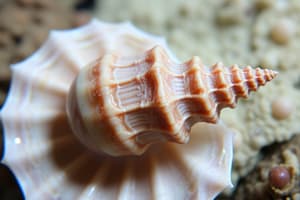Podcast
Questions and Answers
Chitons have 5 to 6 shell plates for locomotion and clamping down on rocks.
Chitons have 5 to 6 shell plates for locomotion and clamping down on rocks.
False (B)
Bivalvia have two shells - one on top and one on bottom of the animal.
Bivalvia have two shells - one on top and one on bottom of the animal.
False (B)
Most Bivalvia have a radula for grazing on algae.
Most Bivalvia have a radula for grazing on algae.
False (B)
Cephalopoda have a reduced foot that is specialized for digging.
Cephalopoda have a reduced foot that is specialized for digging.
Squid have an external, complete shell similar to that of nautilus.
Squid have an external, complete shell similar to that of nautilus.
Octopus use jet propulsion for movement and swimming.
Octopus use jet propulsion for movement and swimming.
Parthenogenesis is a common reproductive strategy among mollusks.
Parthenogenesis is a common reproductive strategy among mollusks.
Arthropods and mollusks both exhibit radial symmetry.
Arthropods and mollusks both exhibit radial symmetry.
Ponifera is a phylum that includes jellyfish and squids.
Ponifera is a phylum that includes jellyfish and squids.
A dichotomous key is used to group organisms based on their evolutionary history.
A dichotomous key is used to group organisms based on their evolutionary history.
The class Gastropoda is characterized by having a hard exoskeleton for protection.
The class Gastropoda is characterized by having a hard exoskeleton for protection.
Chitons are a type of mollusk known for their ability to paralyze prey with nerve toxins.
Chitons are a type of mollusk known for their ability to paralyze prey with nerve toxins.
Arthropods are known to have direct development without any larval stages.
Arthropods are known to have direct development without any larval stages.
Annelids are more effective at flying due to their segmentation characteristics.
Annelids are more effective at flying due to their segmentation characteristics.
Centipedes and millipedes belong to the subphylum Crustacea.
Centipedes and millipedes belong to the subphylum Crustacea.
Chelicerates have jaws for feeding purposes.
Chelicerates have jaws for feeding purposes.
Anthropods have a reduced coelom called haemocoel.
Anthropods have a reduced coelom called haemocoel.
Poly, Hiru, and Oligo are marine invertebrates with no larval stages.
Poly, Hiru, and Oligo are marine invertebrates with no larval stages.
Flashcards are hidden until you start studying
Study Notes
Mollusks
- Chitons have 5 to 6 shell plates for locomotion and clamping down on rocks.
- Bivalvia have two shells, one on top and one on the bottom of the animal.
- Most Bivalvia have a radula for grazing on algae.
- Cephalopoda have a reduced foot that is specialized for digging.
- Squid have an external, complete shell similar to that of nautilus.
- Octopus use jet propulsion for movement and swimming.
Reproduction
- Parthenogenesis is a common reproductive strategy among mollusks.
Symmetry
- Mollusks and arthropods both exhibit radial symmetry.
Phyla
- Ponifera is a phylum that includes jellyfish and squids.
Classification
- A dichotomous key is used to group organisms based on their evolutionary history.
Characteristics
- The class Gastropoda is characterized by having a hard exoskeleton for protection.
- Chitons are a type of mollusk known for their ability to paralyze prey with nerve toxins.
Arthropods
- Arthropods are known to have direct development without any larval stages.
- Annelids are not more effective at flying due to their segmentation characteristics.
- Centipedes and millipedes do not belong to the subphylum Crustacea.
- Chelicerates have jaws for feeding purposes.
- Anthropods have a reduced coelom called haemocoel.
- Poly, Hiru, and Oligo are not marine invertebrates with no larval stages.
Studying That Suits You
Use AI to generate personalized quizzes and flashcards to suit your learning preferences.




